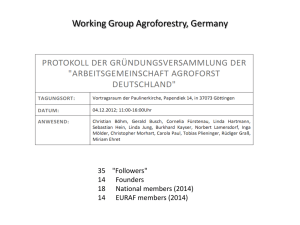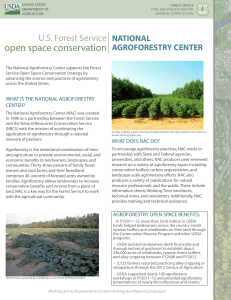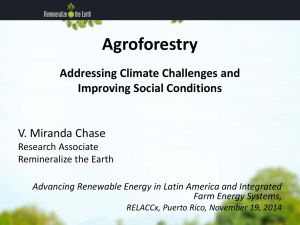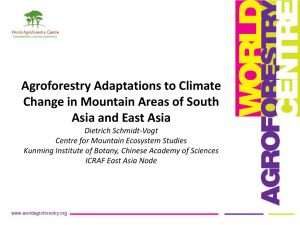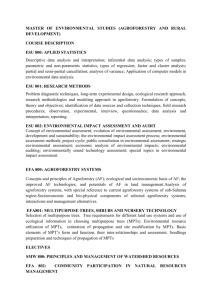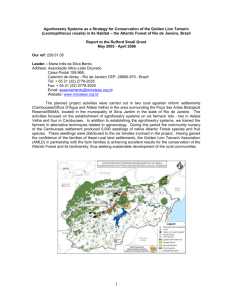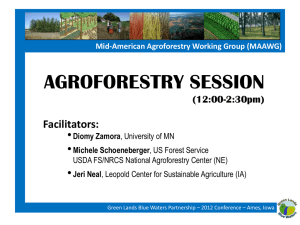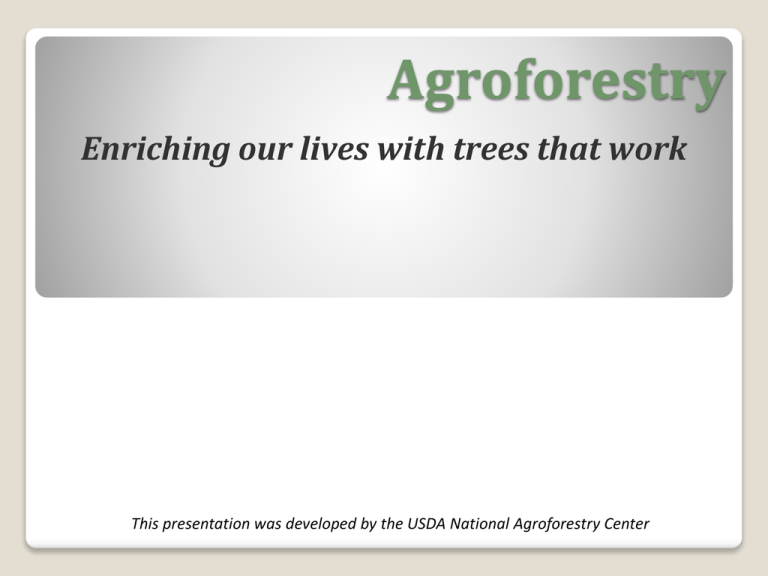
Agroforestry
Enriching our lives with trees that work
This presentation was developed by the USDA National Agroforestry Center
What is Agroforestry?
What are the benefits of agroforestry?
Where can I get more information on
agroforestry?
Presentation Objectives
2
+
What is agroforestry?
3
…..the intentional combining of agriculture and
working trees to create sustainable farming and
ranching systems.
What is Agroforestry?
4
If you are interested in:
•
•
•
•
•
•
Clean water and air
Safe and healthy food
Abundant wildlife
Beautiful places
Clean renewable energy
Sustainable family farms
and ranches
Why Agroforestry?
5
Produces salable products
Provides value-added opportunities
Diversifies risk
Increases property values
Increases crop yields & livestock
production
May be eligible for cost-share
& land rental payments
Why Agroforestry?
6
Here, do this!
Use forestry!
Forestry
Here, do this!
Use agriculture!
Agriculture
7
Putting the right plant, in the right place, for the right purpose!
Agroforestry Practices
8
Plantings of single or multiple rows of trees or shrubs that redirect or modify
the wind and are established for one or more environmental purposes.
Windbreaks
9
Reduce energy costs
Screen unsightly areas
Reduce erosion and pesticide drift
Protect plants
Manage snow
Improve irrigation use
Increase crop yields
Shelter livestock
Mitigate odors and dust
Provide wildlife habitat
Enhance aesthetics
Sequester carbon
Windbreak Benefits
10
Growing an annual or perennial crop simultaneously in the alley ways between
rows of a long term tree crop. The agricultural crop generates annual income
while the longer-term tree crop matures.
Alley Cropping
11
Diversify farm enterprise
Reduce erosion
Improve water quality
Protect crops
Improve utilization of nutrients
Enhance wildlife habitat
Improve aesthetics
Store carbon
Alley Cropping Benefits
12
Combines timber, livestock and forage production on the same acreage. Trees
provide longer-term returns, while livestock generate an annual income.
Silvopasture
13
Improved plant vigor
Lower animal stress
Reduced wildfire risk
Improved wildlife habitat
Annual income (e.g. grazing, hay,
pine straw, hunting)
Long-term income (timber)
Silvopasture Benefits
14
The intentional manipulation, integration, and intensive management of
woodlands under a managed forest canopy to produce non-timber products.
Forest Farming
15
Improve economic value of existing forests
Diversify income
Increase cash flow
Forest Farming Benefits
16
Medicinals
Handicrafts
Decoratives
Food Products
Forest Farming Products
17
Chestnuts
Pecans
Pawpaw
Persimmon
Syrup
Mushrooms
Foods
Black cohosh
Ginseng
Goldenseal
May apple
Witch-hazel
Pacific yew
Medicinals
Bittersweet
Red-twig
dogwood
Forsythia
Corkscrew willow
Pine Straw
Decoratives
Specialty Forest Products
18
Riparian forest buffers are natural or planted woodlands adjacent to
water bodies. They are designed with trees, shrubs, and grasses to
protect water resources from non-point source pollution.
Riparian Forest Buffers
19
Clean water
Protect aquatic habitat
Enhance wildlife habitat
Protect stream banks
Income source (timber and specialty products)
Flood protection
Riparian Forest Buffer Benefits
20
Benefits:
Reduce on farm energy costs
Reduce reliance on fossil fuels
Income source
Improve soil health
Special Applications (Energy Crops)
21
Agroforestry on the farm or ranch
22
Agroforestry Means:
•
•
•
•
•
•
Clean water and air
Safe and healthy food
Abundant wildlife
Beautiful places
Clean renewable energy
Sustainable family farms
and ranches
Summary
23
A number of web sites are available to provide more detailed information
on agroforestry systems. Here are a few:
USDA National Agroforestry Center
http://www.unl.edu/nac/
The Center for Agroforestry
http://www.centerforagroforestry.org/
Association for Temperate Agroforestry
http://www.aftaweb.org/agroforestry-introduction.php
The Center for Subtropical Agroforestry
http://sfrc.ifas.ufl.edu/cstaf/
For Additional Information
24
Acknowledgements
This presentation was developed by the
USDA National Agroforestry Center (NAC),
Lincoln NE.
NAC is a USDA partnership between the U.S.
Forest Service and the Natural Resources
Conservation Service.
National
Agroforestry
Center
A partnership of:
"The U.S. Department of Agriculture (USDA) prohibits discrimination in all its programs and activities on the basis of race,
color, national origin, age, disability, and where applicable, sex, marital status, familial status, parental status, religion,
sexual orientation, genetic information, political beliefs, reprisal, or because all or part of an individual’s income is derived
from any public assistance. (Not all prohibited bases apply to all programs.) Persons with disabilities who require
alternative means for communication of program information (Braille, large print, audiotape, etc.) should contact USDA’s
TARGET Center at 202-720-2600 (voice and TDD).
To file a complaint of discrimination, write USDA, Director, Office of Civil Rights, Room 326-W, Whitten Building, 1400
Independence Avenue, SW, Washington, D.C. 20250-9410 or call (202) 720-5964 (voice and TDD). USDA is an equal
opportunity provider and employer."
25

